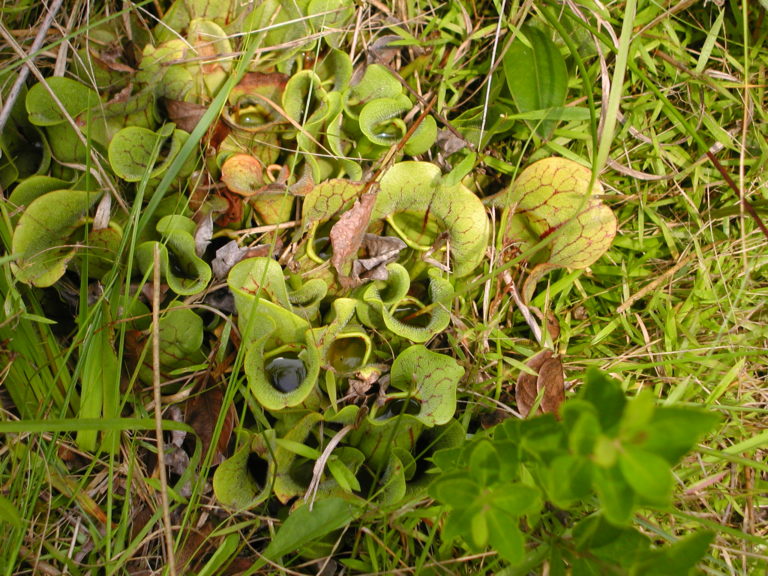Sarracenia purpurea, or Purple Pitcherplant, differs from (most, not all) other species in this genus in several ways. Its pitchers are decumbent rather than upright, squatty and with a large lip; they are open to the sky instead of being protected by a hood, and are therefore probably full of water at any particular time; the hood is more vertical, with beautiful venation, and it is outfitted with stiff hairs oriented towards the orifice; the traps generally function for two seasons rather than one; and finally, the range of this species is orders of magnitude greater than the ranges of other species. It is found not only in the Southeastern states but also the Northeast, Midwest and all across Canada to British Columbia! The species is divided into two subspecies, S. purpurea ssp. purpurea (from New Jersey north) and S. purpurea ssp. venosa (New Jersey south). Also, its strategy for obtaining critical nutrients from its prey differs. While its capturing mechanism is not as efficient as it is in the upright pitcherplant species, the prey that do fall into the water are digested most efficiently! Young pitchers of S. purpurea produce digestive enzymes, but during the second season digestion is greatly aided by a whole community of microscopic creatures cultured in the water (see Wikipedia!). Nutrients, especially nitrogen and phosphorus, are absorbed. Like the more upright pitcherplants, these plants are sun- and water-lovers, and if not grown in a pond can easily be grown in a container of peat moss and perlite or sand, watered with distilled or deionized water, in full sun.
NURSERY HOURS
Wednesday: 10-4 Thursday: 10-6 Friday-Saturday: 10-4 Sunday: 12-4
Sarracenia purpurea

Key Info
Scientific Name: Sarracenia purpurea L.
Common Names: Purple Pitcherplant, Flytrap, Northern Pitcherplant, Turtle Socks, or Side-saddle Flower
Family Names: Sarraceniaceae
Light Requirement: Full sun
Leaf Retention: Evergreen
Flower Color: Purplish to red
Additional Info
Habit: Sarracenias are clump-forming herbaceous perennials that grow as rosettes from a branching rhizome, forming colonies and containing fibrous roots 8-12 inches long along its length. The pitchers are modified leaves that (in addition to their function of photosynthesis) attract and entrap their insect prey by means of colorful presentation and nectar production (like flowers) and modifications to prevent escape. Wikipedia has a concise treatment of Sarracenia's entrapment mechanisms.
Height: 6-12"
Spread: 1'-2'
Soil Conditions: Moist or wet, nutrient-poor, peaty, acidic soils.
Leaves: The pitchers of S. purpurea are decumbent, up to about 12" long, swollen, with an undulating wing or extension along its length, a hood that is somewhat vertical rather than protecting the orifice, and more often than not containing water. They are often green with varying amounts of maroon coloration.
Flowers (or reproductive structures: Purple-red petals hang down from a tall inverted flower. Flowers are held above the pitchers, avoiding entrapment of pollinators.
Fruit: Each flower is followed by a dry 5-parted seed capsule that splits open along 5 seams at maturity (June/July) exposing small, papery, pear-shaped seeds. The seeds fall near the parent plant.
Natural Distribution: Sphagnum bogs and moist savannahs; in the Carolinas it is rare in the coastal plain, very rare in isolated bogs in the piedmont and mountains.
USDA Hardiness Zone: 4 to 8
USDA Wetland Indicator Status in NC: OBL
Pollination: Bees, and other insects.
Wildlife Connections: Obtains nutrients (nitrate and phosphate) from insects. Flies, ants, spiders, moths and other tiny creatures are attracted by the nectar and coloration of the traps. The main prey of Sarracenias are ants, flies, wasps, bees, beetles, spiders, moths, slugs and snails.
Propagation: Sarracenias can be propagated from seed or, more frequently, by division.
